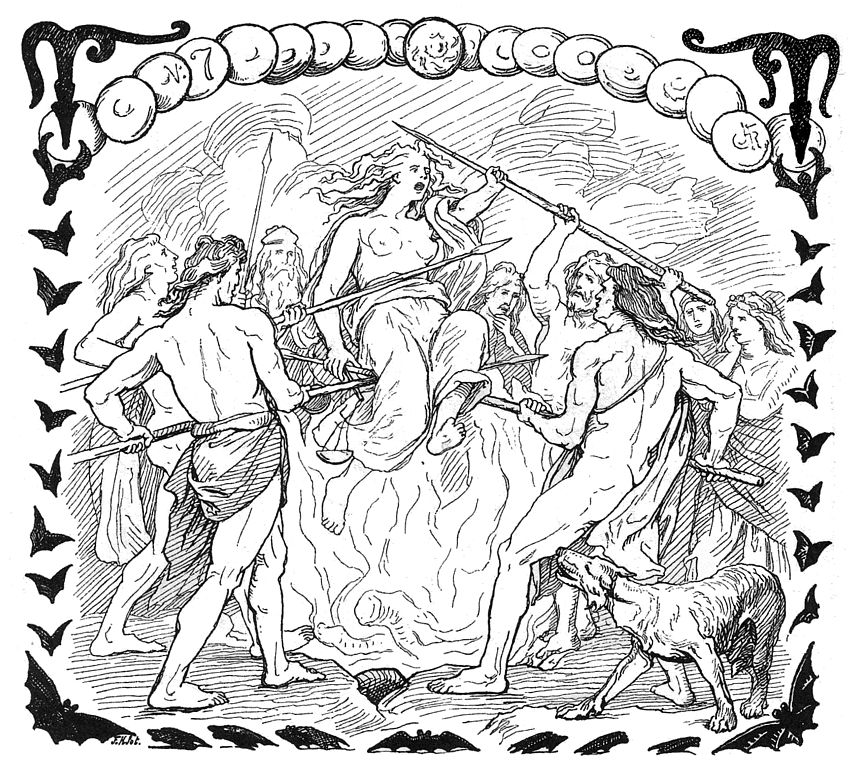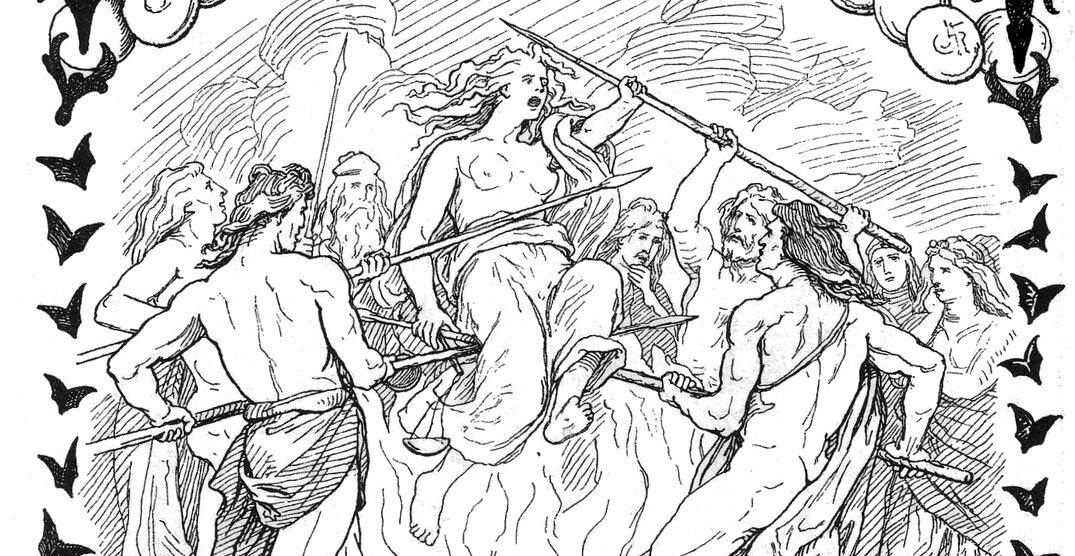In Old Norse mythology, Gullveig was a völva (a sorceress or shaman) that may have caused the legendary war between the realms of Æsir and Vanir.
The poem Völuspá (Poetic Edda) describes her visit to Odin’s (or Hár) hall in Asgard, the capital of the Æsir. Odin had her impaled with spears and burnt three times, yet each time, she survived. She took the name Heiðr after the ordeal.
Gullveig is often described as a jötunn from Jotunheim, the land of the giants in Old Norse myth.
What Is Gullveig The Goddess Of?
It is not clear that Gullveig was a goddess. However, she was an accomplished witch or shaman – a völva in Viking mythology – who practiced the Vanir magic called seidr (also written as “seið”).
One translation of a section of the poem Völuspá describes her as follows:
Heid, they called her wherever she visited,
Germanicmythology Org
a far-sighted seeress; she conjured with wands;
in magic, she was versed; in magic, she was deft.
In a trance, she practiced seidr.
She was always a delight to evil women.
Gullveig’s Name meaning
Gullveig is depicted as a witch or völva and is often associated with gold. Indeed, Gullveig’s name can be translated as “gold strength” or “gold power,” and various sources mention her obsession with gold. They attribute the Asgardian soldiers’ attack on her as being provoked by her constant references to the subject when she visited the “hall of Hár.”
The name Gullveig consists of two parts: the Old Norse word for gold (gull) and power or strength (“veig” is Icelandic for “strength”).
The name Heiðr (also known as Heid and Heith) she took after her stabbing and burning means “bright” or “clear” and has a semantic relation with “Gullveig.”
Austrian philologist and religious studies scholar Rudolf Simek believes that despite the name change, the meaning stays the same.
The Story Of Gullveig
Scholars have suggested Gullveig/Heiðr is the same character as the goddess Freyja, that Gullveig’s death might have connections to Æsir corruption over the desire for gold, and that the Æsir’s treatment of Gullveig’s may have provoked the Æsir-Vanir War, also known as the “First War.”
The Vanir was a race of gods associated with wealth, fertility, and commerce, directly juxtaposing the warlike Æsir gods. As compensation for the attempted killing of the Vanir goddess Gullveig, Vanaheim (home of the Vanir) demanded reparations from Asgard. War broke out between the two realms after the Aesir refused.
Two stanzas from the Völuspá describe how the Vanir witch Gullveig came to Odin’s Hall in Asgard, was speared and burnt three times, returning to life on each occasion. On her third reincarnation, she took the identity of Heiðr.
The Danish painter Lorenz Frølich created a well-known illustration in 1895 of the Æsir using spears to lift Gullveig over a fire.
The war was brutal, with each side incurring heavy losses. They eventually fought each other to a standstill, resulting in a peace treaty involving an exchange of high-profile figures from both sides. The Vanir sent the gods, Njord, Freyja, and Freyr, to the Æsir in exchange for Hoenir (possible brother of Odin) and the sage Mímir.

Is Freyja Gullveig?
Gabriel Turville-Petre, John Lindow, and Simek have postulated the theory that Gullveig/Heiðr is the same figure as the Vanir goddess Freyja.
Freyja owns the golden necklace Brísingamen and weeps golden tears. The Ynglinga Saga also says that Freyja was the first to perform seidr in Asgard and the person who taught it to Odin.
So, Freyja and Gullveig both share the same defining characteristics – gold and seidr – making the theory of them being the same person something to consider seriously.
Gullveig Attestations
You can only find attestations of Gullveig/Heiðr in the Poetic Edda, a 13th-century set of Old Norse poems. It is not to be confused with the collection of Old Norse texts called the Prose Edda that the Icelandic poet and historian Snorri Sturluson compiled.
Her attestations appear in two stanzas of Völuspá (Prophecy of the Völva).
Odin presses a völva (seeress) to reveal some of the secrets of Norse history. She tells him she also knows some of his secrets, and one of the tales she tells reveals the story of Gullveig in Hár’s (an alias of Odin’s) Halls:
She remembers the world’s first war
The Comparative Völuspá Stanzas 19-21 – Mimmisbrunnr Info
when Gullveig was pierced with spears
in the High One’s hall; she was burnt.
Thrice burnt, thrice born,
often, not seldom, yet she still lives.
Loki And Gullveig’s Heart
The Völuspa also mentioned that Loki ate part of Gullveig’s half-cremated heart every time she was reborn and absorbed some of the evil woman’s soul, persona, and magic.
He later gave birth to Odin’s horse Sleipnir after copulating (while shapeshifted into a mare) with the stallion Svaðilfari.
Gullveig was burnt and reborn three times, and it is maybe no coincidence that Loki also fathers three monsters prophesized to play a prominent role in Ragnarök, the Norse end of days, afterward. He and the jötunn Angrboda produce the huge and horrible wolf Fenrir, the ruler of the realm of the dead Hel, and the gigantic serpent Jörmungandr:
Loki begat the wolf with Angrboda,
Germanicmythology Org
but Sleipnir he begat with Svaðilfari:
one monster seemed of all most deadly,
which from Byleist’s brother [Loki] sprang.
Loki ate the heart a little burnt,
he found half-scorched the woman’s life stone.

